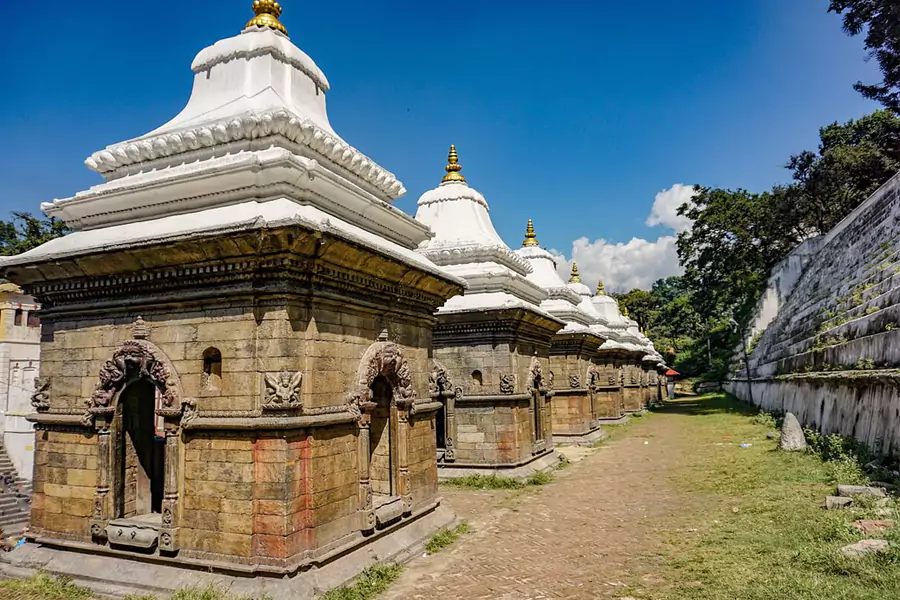Pashupatinath Temple
Pashupatinath Temple is among the holiest shrines of Hinduism, dedicated to Lord Pashupatinath, an incarnation of Lord Shiva. The temple stands gracefully on the banks of the sacred Bagmati River in Kathmandu, the capital city of Nepal. Though nestled in the Kathmandu Valley, its reputation draws devotees from every part of the world. Pilgrims arrive here in large numbers to seek blessings and experience the spiritual aura of this holy place.
The temple holds the honor of being a UNESCO World Heritage Site.
Inside the Pashupatinath complex, visitors will find numerous smaller temples and ashrams. The architecture is captivating, with intricately designed doors and golden roofs that reflect Nepal’s rich heritage.
Location
Pashupatinath Temple is located around 5 km northeast of Kathmandu Valley, on the western bank of the Bagmati River. The small settlement where the shrine stands is known as Deopatan.
Religious Significance
The importance of Pashupatinath is well described in the ancient scripture Shiva Purana. In Hindu belief, the twelve Jyotirlingas of India represent Lord Shiva’s body, while the Jyotirlinga at Pashupatinath is revered as the head. Because of this, the temple carries immense spiritual weight among devotees.
Many Hindus wish to spend their final days at Pashupatinath. It is believed that dying and being cremated here ensures rebirth as a human, regardless of past karma. The temple is also associated with astrologers who, according to tradition, can foretell the exact time of death.
A popular legend narrates that Lord Shiva once escaped from other gods in Varanasi and reached the Bagmati forests. Taking the form of a deer at Mrigasthali, he hid with Goddess Parvati. When discovered, he leapt across the river, leaving behind a broken horn that split into four pieces. This led to the manifestation of Lord Shiva as Pashupatinath in a four-faced lingam form.
History
The precise origins of Pashupatinath Temple remain uncertain, though it is believed to have been first established in the 3rd century BC by Pashupreksha of the Somadeva Dynasty. The foundation is attributed to the Pashupata sect, and similar replicas later appeared in Bhaktapur, Lalitpur, and Varanasi.
Over centuries, the temple faced destruction multiple times. The current structure was built by King Bhupalendra in 1697. Since then, several additional shrines have been constructed around it, forming today’s vast temple complex. Historical records also suggest that the site dates back as early as 400 BC, making it the oldest temple in Kathmandu.
Temple Architecture
The shrine showcases the classic Nepalese pagoda style. Its cubic design features four ornate doors, each covered with precious metals. The two-tiered roof, made of copper and plated with gold, adds to its magnificence, while the pinnacle is entirely gold.
The complex is divided into two sections: the outer corridor and the inner sanctum, where the revered lingam is placed. Every corner of the temple is richly adorned with wood carvings and metalwork. A striking golden statue of Nandi, the sacred bull of Lord Shiva, stands in front of the sanctum, enhancing the temple’s charm.
What to See
The temple complex houses nearly 518 smaller shrines and monuments. Within the main courtyard, numerous temples dedicated to different deities can be found. To the south lies Chadeshvar Temple (7th century), while the Brahma Temple is to the north and the Vasuki Temple to the northeast.
Other notable shrines include:
- Surya Narayan Temple
- Unmatta Bhairav Temple
- Kirti Mukh Bhairav Shrine
- Hanuman Shrine
- Ram Mandir
- Virat Swaroop Temple
- Guhyeshwari Temple
- The 12 Jyotirlinga
- Pandra Shivalaya
The Bagmati River itself is deeply sacred. Devotees can be seen performing rituals, bathing in its waters, or offering prayers at the many ghats. Monkeys and deer roam freely, while sadhus and ascetics create an atmosphere of devotion. Arya Ghat, the royal cremation site, and Bhasmeshvar Ghat, known for open-air cremations, are key spots. Gauri Ghat is another sacred bathing place for pilgrims.
Festivals
The temple attracts devotees daily, but during festivals it transforms into a vibrant hub of devotion. Major occasions include:
- Ekadashi
- Sankranti
- Teej
- Mahashivratri – celebrated with unmatched enthusiasm. During Shivratri:
- Thousands of oil lamps illuminate the temple
- Rituals continue all night
- The temple remains open for darshan and prayers
How to Reach
Once in Kathmandu, visitors can reach Pashupatinath using:
- Local buses from Ratna Park or the City Bus Station (often crowded)
- Taxi – a more comfortable option. The drive usually takes about an hour, depending on traffic
Top 5 Untold Facts About Pashupatinath Temple
If you enjoy exploring sacred sites, Pashupatinath is a must-visit. Here are five remarkable facts about the temple:
- Four-faced Shiva Lingam: The temple houses a unique lingam with four faces—Tatpurusha (east), Sadhyojata (west), Vamdeva (north), and Aghora (south). No other Shiva temple has such a lingam.
- Four Priests Only: Rituals inside the sanctum are performed exclusively by four priests belonging to the Bhatta and Rajbhandari groups.
- Arya Ghat: This sacred ghat, used for both rituals and cremations, supplies holy water for worship at the temple.
- Restricted Entry: Only Hindus are permitted inside the sanctum sanctorum, keeping the rituals and traditions strictly preserved.
- Artistic Heritage: The temple is home to exquisite paintings, inscriptions, and sculptures. The beautifully decorated doors are especially noteworthy.
Conclusion
If you are longing for peace of mind and a soulful retreat, Pashupatinath Temple is the perfect place to visit. Step into the sacred temple complex and fulfill your spiritual journey with divine blessings. Let the atmosphere of Pashupatinath surround you with serenity and devotion, offering an experience unlike any other.



